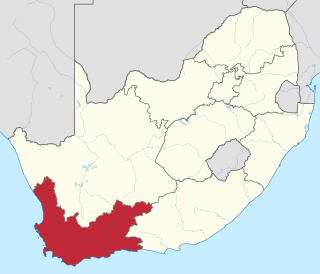
The Western Cape is a province of South Africa, situated on the south-western coast of the country. It is the fourth largest of the nine provinces with an area of 129,449 square kilometres (49,981 sq mi), and the third most populous, with an estimated 7 million inhabitants in 2020. About two-thirds of these inhabitants live in the metropolitan area of Cape Town, which is also the provincial capital. The Western Cape was created in 1994 from part of the former Cape Province. The two largest cities are Cape Town and George.

The Potamogetonaceae, commonly referred to as the pondweed family, is an aquatic family of monocotyledonous flowering plants. The roughly 110 known species are divided over six genera. The largest genus in the family by far is Potamogeton, which contains about 100 species.
Antitropicaldistribution is a type of disjunct distribution where a species or clade exists at comparable latitudes across the equator but not in the tropics. For example, a species may be found north of the Tropic of Cancer and south of the Tropic of Capricorn, but not in between. With increasing time since dispersal, the disjunct populations may be the same variety, species, or clade. How the life forms distribute themselves to the opposite hemisphere when they can't normally survive in the middle depends on the species; plants may have their seed spread through wind, animal, or other methods and then germinate upon reaching the appropriate climate, while sea life may be able to travel through the tropical regions in a larval state or by going through deep ocean currents with much colder temperatures than on the surface. For the American amphitropical distribution, dispersal has been generally agreed to be more likely than vicariance from a previous distribution including the tropics in North and South America.

Ruppia, also known as the widgeonweeds, ditch grasses or widgeon grass, is the only extant genus in the family Ruppiaceae, with eight known species. These are aquatic plants widespread over much of the world. The genus name honours Heinrich Bernhard Rupp, a German botanist (1688-1719). They are widespread outside of frigid zones and the tropics.
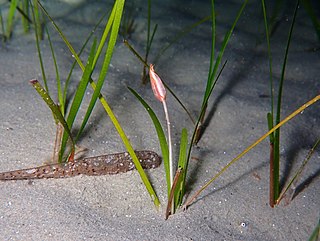
Cymodoceaceae is a family of flowering plants, sometimes known as the "manatee-grass family", which includes only marine species.
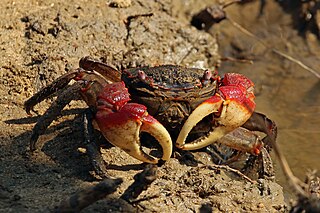
The Southern Africa mangroves are mangrove ecoregion on the Mozambique's southernmost coast and the eastern coast of South Africa.
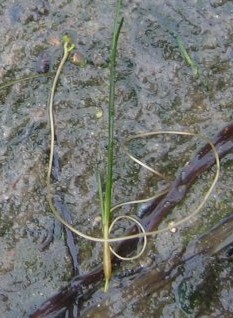
Ruppia cirrhosa is a species of aquatic plant known by the common names spiral ditchgrass and spiral tasselweed. It is native to the Americas and Europe, where it grows in freshwater bodies, such as lakes. It is a thread-thin, grasslike perennial herb which grows from a rhizome anchored in the wet substrate. It produces a long, narrow inflorescence tipped with two tiny flowers. As the fruit develops the peduncle of the inflorescence curls into a neat spiral.

Ruppia maritima is an aquatic plant species commonly known as beaked tasselweed, beaked ditchgrass, ditch grass, tassel pondweed and widgeon grass. Despite its scientific name, it is not a marine plant; is perhaps best described as a salt-tolerant freshwater species. The generic name Ruppia was dedicated by Linnaeus to the German botanist Heinrich Bernhard Ruppius (1689–1719) and the specific name (maritima) translates to "of the sea".
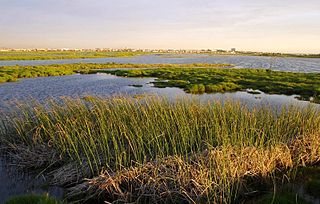
The Rietvlei Wetland Reserve is a 663-hectare (1,640-acre) nature reserve situated in Table View, Western Cape, South Africa. It is managed by the City of Cape Town's Environmental Resource Management Department.

Southern Afrotemperate Forest is a kind of tall, shady, multilayered indigenous South African forest. This is the main forest-type in the south-western part of South Africa, naturally extending from the Cape Peninsula in the west, as far as Port Elizabeth in the east. In this range, it usually occurs in small forest pockets, surrounded by fynbos vegetation.

Macroplea mutica is a species of leaf beetles of the subfamily Donaciinae. It considered to be a Palearctic species, but can be found in Central Europe and Turkey.
Ruppia megacarpa is a submerged herb species in the genus Ruppia found in shallow brackish waters. It is a common on Australasian coasts, including Australia (NSW; SA; Vic; WA and New Zealand. Isolated populations have been currently found in East Asia, including Japan, Korea, and Far East Russia, hence, the species distribution exhibit latitudinally disjunct distribution between East Asia and Australasia.

Ruppia tuberosa is a submerged herb in the genus Ruppia found in shallow hypersaline waters in Australia.
Chloroplast capture is an evolutionary process through which inter-species hybridization and subsequent backcrosses yield a plant with new genetic combination of nuclear and chloroplast genomes. For instance, 1) species A's pollen hybridizes (backcross) to species B's ovule, yielding the 1st hybrid (F1) with chloroplast genome b and nuclear genome A (50%) and B (50%); 2) species A's pollen again hybridizes (backcross) to F1's ovule, yielding the 2nd hybrid (F2) with chloroplast genome b and nuclear genome A (75%) and B (25%); 3) species A's pollen again hybridizes (backcross) to F2's ovule, yielding the 3rd hybrid (F3) with chloroplast genome b and nuclear genome A (87.5%) and B (12.5%); 4) after further backcross generations, a plant is obtained with the new genetic combination.
Norio Tanaka is an aquatic botanist at Tsukuba Botanical Garden, National Science Museum, Tokyo, Japan.
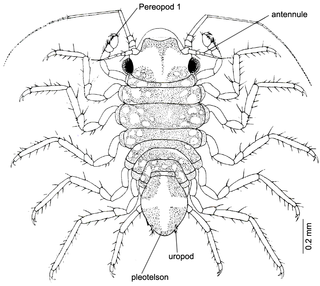
Uromunna sheltoni is a species of isopod first described by Brian Kensley in 1977. U. sheltoni is included in the genus Uromunna and family Munnidae. No subspecies are listed. The species was first collected by Peter Shelton of the University of Cape Town, for whom it is named.
Heinrich Bernhard Rupp was a German botanist.
Ruppia spiralis is an aquatic plant species in the genus Ruppia of the family Ruppiaceae. This name was synonymized under R. cirrhosa, but it has been resurrected for the species previously referred to as R. cirrhosa.
Ruppia drepanensis is a species of plant in the family Ruppiaceae.











